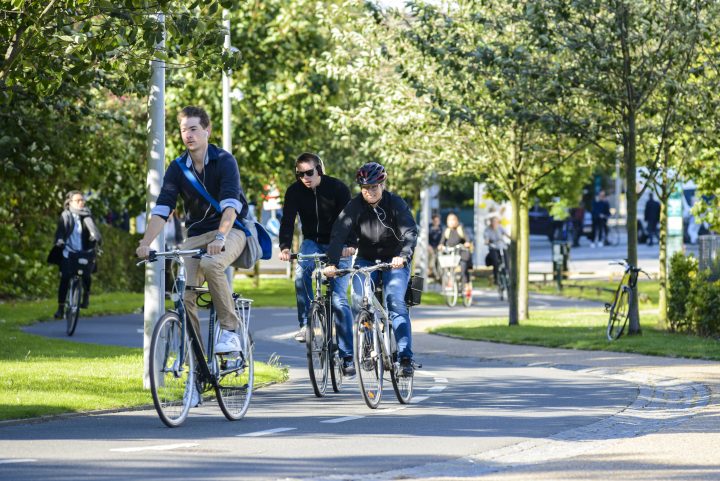Cycling and health
Cycling is good for the economy as well as the well-being, welfare and quality of life of the individual.
By Jens Troelsen, University of Southern Denmark
Cycling is good for you, even with low intensity and over short distances. Cycling has a major role to play in public health and can counteract the present negative spiral of physical inactivity and overweight, nationally and globally.
The Danish social profile shows that more people are overweight (BMI>=25) than normal weight (BMI 18.5-25). Cycling conditions in Denmark are excellent. If more Danes cycle on a weekly basis, it will improve public health and reduce the number of illnesses that require treatment.
The present article offers insights into why cycling is good for the economy, and why it’s good for the individual as well when it comes to well-being, welfare and the quality of life.
Public health challenges connected with physical inactivity
Physical inactivity is on the rise globally. This is also true of Denmark where manual labor is losing ground as new technologies at the workplace and at home enable machines, robots and other aids to carry out physically demanding tasks. This means more sedentary jobs and fewer hours spent on household chores such as vacuuming, mowing the lawn, cooking, etc.
Hours spent in sedentary transport are also on the rise as Danish households acquire more and more cars, and commute over longer and longer distances. In our leisure hours we spend more and more time in front of a screen due to the rapid increase of streaming services, and computer and console games. All in all, we do not get enough exercise according to the general recommendations for health and physical activity.
The health data of more than 180,000 Danes collected in 2017 confirms this. According to the national health profile of 2017 (Danskernes Sundhed— Den Nationale Sundhedsprofil 2017) there is a comparatively large share of adult Danes who do not follow WHO’s recommendations that adults should do at least 150 minutes of physical activity a week. A total of 28.8% of the adult population do not follow WHO’s minimum recommendation for physical activity.
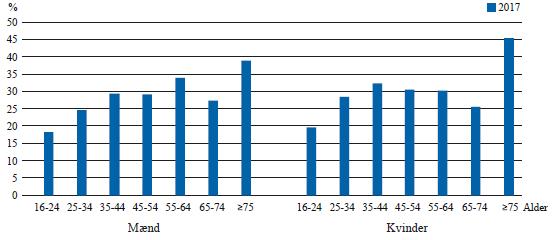
- Figure 1: The percentage share of Danish men (left) and women (right) in different age groups who do not follow WHO’s minimum recommendation for physical activity in 2017.
As can be seen in Figure 1 there is no significant difference between men and women. The smallest share is among 16-24 year old men (18.2%) and women (19.7%) and largest in the 75 + age group for both men (38.8%) and women (19.7%) The share who do not follow the minimum recommendation for physical activity is larger among persons with only a primary school education (42.4%) and persons on early retirement (43.4%).
The health profile study further shows that the adult population has at least 8 hours of sedentary time on a typical weekday. There is a significant connection here between education level and sedentary time. The amount of sedentary time among persons with only a primary education is 37%, but jumps to 77.4% for persons with a long-term higher education.
Easy access to cheap, ready-made, high-calorie food, which is easy and convenient during a busy week, combined with increasing inactivity has resulted in the steady increase in the number of Danes who are moderately to severely overweight.
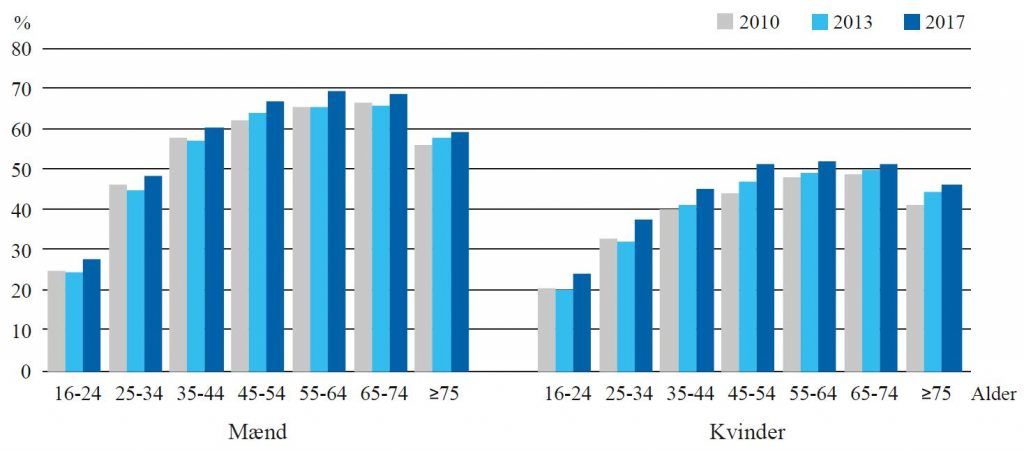
- Figure 2: Percentage share with moderate to severe overweight among men and women in different age groups in the years 2010, 2013, and 2017.
As Figure 2 shows there has been a steady increase in overweight (BMI >=25) since 2010. This is true for both men and women in almost every age group. According to the most recent statistics from 2017, 51% of the adult population is moderately or severely overweight. It is thus more normal to be overweight than normal weight (BMI 18.5-25). One out of ´six Danes (16.8%) is severely overweight (BMI>=30). The share of severely overweight persons has more than tripled over only 20 years.
There is a close connection between educational level and severe overweight. Among persons with only a primary education 26.3% are severely overweight as opposed 8.1% of persons with a long term higher education. Severe overweight increases the risk of developing a number of chronic illnesses, wear- and -tear of muscles, tendons and joints, social isolation, failure to thrive, low self-worth and depression.
Increased awareness of cycling as a significant health factor
In recent years there has been a growing awareness of cycling’s societal role in addressing the public health challenges connected with physical inactivity. A review carried out in 2017 identified 13% more scientific publications on the subject during the period 2011-2016 than during the period 1991-1995.
This shows that cycling has been attracting considerably greater scientific attention, but also indirectly indicates a demand for more knowledge about why and how cycling should be promoted in order to address societal challenges. The challenges from air and noise pollution, traffic congestion, the economy, environmental and social sustainability have often been motivating factors, but the primary reason for the increased interest in studying the effects of cycling is the public health issue. The following presents an overview of well-documented knowledge about cycling and health.
What cycling means for health
From a physiological point of view the physical activity of cycling is no different than any other type of physical activity with the same intensity, duration and frequency, such as manual labour, training, sports, and walking. In other words cycling has the same health effects as any other type of general physical activity. However, cycling can also be considered a risk behavior with negative aspects such as increased risk of traffic accidents, falls and air pollution, and added unpleasantness for the individual in the form of rain, cold and shortness of breath.
When weighing the positive and negative aspects of cycling there are understandable reasons for the reluctance to choose cycling as a transport form, both on the societal level among politicians and urban planners, and on the individual level among drivers and users of public transport. When the negative aspects tip the scales, the tendency to opt out of cycling will obviously be greater.
The following shows that the positive benefits of cycling far outweigh the negative consequences when the context is limited to the issue of cycling and health. This is especially true of countries like Denmark and Holland with highly developed cycling cultures, and where there are relatively few traffic accidents involving cyclists in relation to the large number of cyclists and kilometers cycled. First, however, let us take a look at the positive health effects of cycling.
Positive health effects of physical activity
Cycling has a positive effect on health. Table 1 is an overview of the health effect of physical activity.
| Physical activity has a positive impact on: | Physical activity reduces the risk of: |
| Life expectancy | Cardio-vascular disease |
| Cardio-vascular fitness | High blood pressure |
| Musculoskeletal fitness | Blood clots |
| Healthy body composition | Type 2 diabetes |
| Bone strength | Metabolic syndrome |
| Sleep quality | Breast and colon cancer |
| Quality of life | Depression |
| Independent physical mobility | Falls |
| Cognitive function | Dementia |
Table 1: Overview of health effects of physical activity
Large population studies document the health effects of physical activity regardless of age, ethnicity, weight and gender (with the exception of breast cancer where only the effect on women is documented). Cycling will therefore benefit the physical and mental health of all social groups, and can reduce the risk of developing a large number of illnesses.
Studies show that regular physical activity reduces the risk of all- cause mortality by up to 30%. Physical activity counteracts the risk of developing type 2 diabetes by up to 40% and dementia by up to 30%. Figure 3 is an overview of some of the diseases where physical activity has a favorable effect.

- Figure 3: Health effects of physical activity Reference: Public Health England: Physical activity: applying All Our Health, 2018
The physiological health effect of cycling
Documented knowledge about the health effect of physical activity is based on major epidemiological studies in which large, moderately active population groups are compared with physically inactive population groups. This makes it possible to study the effect of physical activity in relation to mortality, life style diseases and risk behaviours, among other things,
Transport cycling is considered a physical activity of moderate intensity so it may be assumed that cycling regularly over a given distance will have the health effect discussed above. However, studies have been carried out that limit the focus to cycling as a specific type of activity with specific effects.
The first major study of the specific effects of cycling was published in the year 2000. 30,640 Copenhagen citizens between the ages of 20-93 participated in a 28 year cohort study, 8,549 of whom died along the way. 783 of the women and 6,171 of the men reported that they cycled to and from work, an activity with a weekly average duration of three hours.
The study, which was adjusted for BMI, blood pressure, smoking, and other types of leisure time physical activity, showed that cycling to work taken as an isolated factor reduced the risk of all-cause mortality by 28%. This result was subsequently confirmed in a large Chinese cohort study of women, which identified a reduced mortality risk of 21% when cycling to work 3.5 times weekly.
A large British study of transport habits among 263,450 adults in 2017 showed in a five year follow-up study that cycling to work was connected with a 41% lower risk of premature mortality compared to drivers and users of public transport. Compared to other road users cyclists had a 52% lower risk of dying of heart disease, 40% lower risk of dying of cancer, 46% lower risk of developing heart disease, and 54% lower risk of developing cancers.
Most recently a meta-analysis of 7 large cohort studies of more than 2 million persons showed that 150 minutes of cycling a week reduced mortality by 10%.
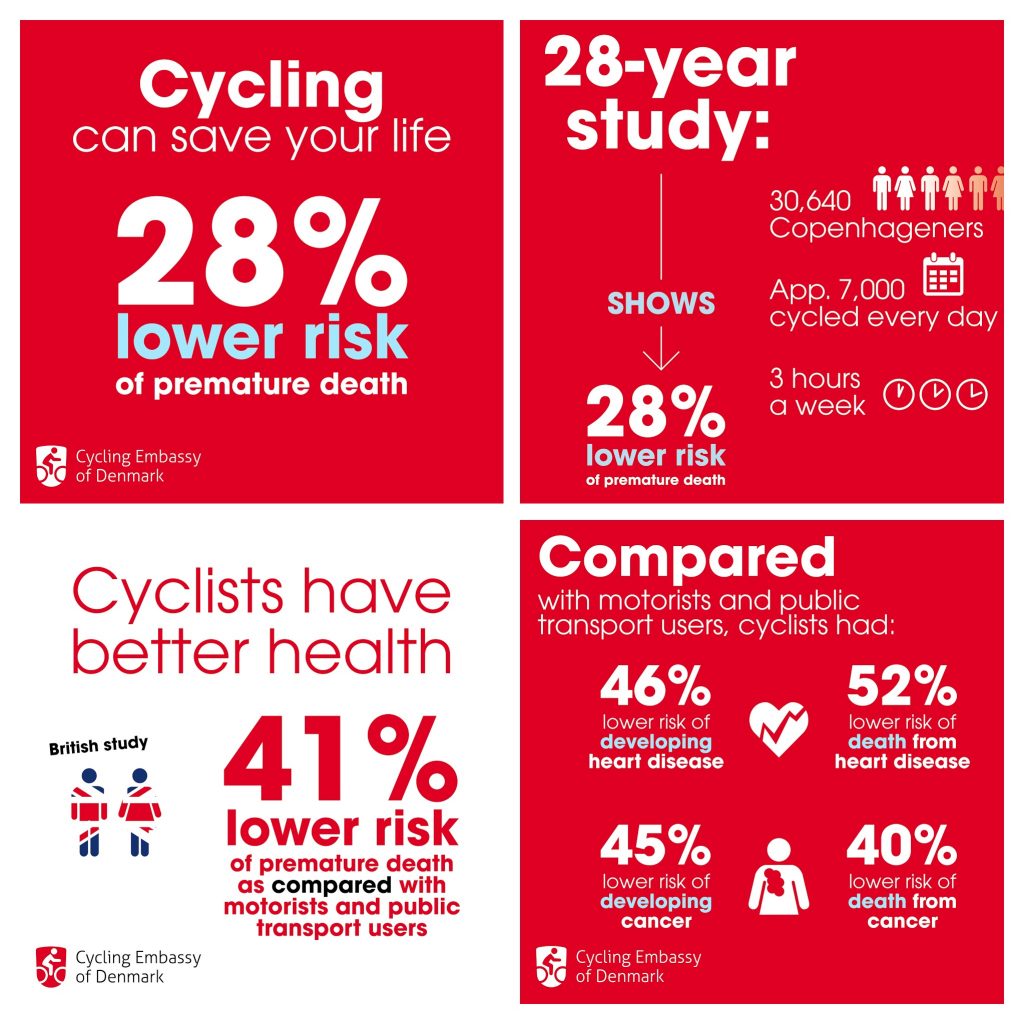
How much cycling is necessary?
The results of large epidemiological population studies constitute the basis for WHO’s recommendation of 150 minutes of weekly physical activity. There is a documented health effect when active groups are compared with inactive groups.
By the same token the Danish Health Authority recommends that “adults, in addition to normal, daily activities of short duration, should be physically active at least 30 minutes a day with moderate to high intensity. If the 30 minutes are split up, each activity should last at least 10 minutes. There should be high intensity activity of at least 20 minutes’ duration at least twice a week, which should include activities to increase bone strength and mobility.”
This is roughly the equivalent of cycling about 6 km to and from work at the rate of 12-15 km/h on a daily basis, where stops and acceleration due to intersections along the way increase the heart rate. If in addition to cycling there are weight bearing activities in connection with gardening, household chores, or going up and down stairs, most people will be able to follow the Danish Health Authority’s specific recommendations without spending time on further training.
Large studies have shown a non-linear effect connected with cycling. This means that the first 1-2 hours of cycling a week has approx. twice the health effect of the following hours cycled. Cycling for many hours a week will have a continued health effect that reduces the risk of life style diseases in relation to cycling volume, but the effect size will decrease. Consequently, cycling will have a comparatively greater effect on the physically inactive who begin to cycle a few hours a week.
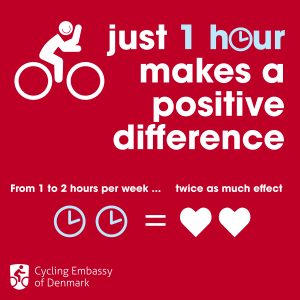
A large Danish study of 53,723 Danes aged 50 – 65 over a period of 20 years showed an effect of even a small amount of cycling. Those who cycled regularly for at least one hour a week at the study’s start had an 11-18% lower risk of heart disease compared with those who did not cycle at the study’s start.
Those who did not cycle from the start, but began within the first five years had a 26% lower risk of developing heart disease compared with non-cyclists. The group that started later cycled approx.1 ½ hours average. It is therefore never too late to start cycling, the health effect can be achieved with a few hours of weekly cycling, and will be greatest if the person is otherwise generally inactive.
The mental health effects of cycling
Many health experts consider transport- related cycling to be one of the best ways of making physical activity an integral part of everyday life. Moderate physical activity on a regular basis has a physiological effect, and can easily fit into a busy life when transport needs are feasible.
However, large Danish and international studies have shown that the most frequently cited factor preventing us from being physically active is lack of time. After decades of campaigns hardly anyone today is in doubt that physical activity is healthy, but as shown above a large share still don’t follow the health recommendations.
Many people would be able to overcome the time barrier by cycling to and from work or when shopping or transporting children since any extra time required by cycling would not usually exceed the recommended 30 minutes a day. Cyclists can follow the recommendations as well as gain extra time on a busy day by dealing with physical activity and mobility needs at the same time. This is one of many explanations why several studies show that when cyclists are compared with other road users, cyclists report improved quality of life, lower stress levels and enhanced well-being.
Several studies show that cyclists claim to have a higher degree of mobility, freedom of movement, and independence in traffic compared with users of public transport. In comparison with drivers, cyclists cite a higher degree of physical well-being, surplus energy and social contact. So in addition to the physiological effects of cycling, there is also a documented mental health effect.
Is cycling dangerous?
If politicians, planners and health experts are reluctant to support the promotion of cycling, this is partly due to the fact that cycling is perceived as a risk behaviour. Since cyclists are vulnerable road users exposed to heavy traffic and air pollution, cycling can be perceived as dangerous. However, numerous studies show this is far from the case, and the health benefits far outweigh the negative aspects connected with cycling
When cycling is considered dangerous it is often based on the number of traffic accidents involving cyclists, but in a risk assessment cycling should be seen in relation to the amount of time spent cycling and the number of kilometers cycled. This shows that in the US, for example, there are 5.5 cyclist fatalities per 100 million kilometers cycled. The risk is thus relatively low, even in the US. Compared to Denmark, on the other hand, the risk is five times greater where only 1.6 cyclists are killed per 100 million kilometers cycled.

- Figure 4: Fatalities and injuries per kilometer cycled in Holland, Denmark, Germany, Great Britain, and the US. Reference: Puncher and Buehler (2012), MIT Press
In Denmark there was a small drop in the number of cyclist fatalities and the number of serious cyclist casualties in the period 2008-2017. In 2017 there were 475 serious cyclist casualties and 27 fatalities.
Taken in isolation 27 cyclist fatalities are 27 too many, but in the bigger picture this should be seen in relation to the many extra person -years gained by cycling. A New Zealand study shows that when cycling increases nationally, the projected number of extra serious cyclist casualties in 2051 will be 85-250, but at the same time the increase in cycling will reduce the annual number of premature fatalities to somewhere between 450 -4,000 due to increased physical activity.
Another cost-benefit study shows that the average cost of getting drivers who daily drive 10 km to switch to cycling instead will be DKK 370 per person per year since treatment and hospitalization may be expected due to collisions and falls. However, the extra costs should be seen in relation to the fact that the extra number of kilometers cycled means an average annual health cost reduction of DKK 9,700 per person per year. The health cost reduction is thus 26 times greater than the cost.
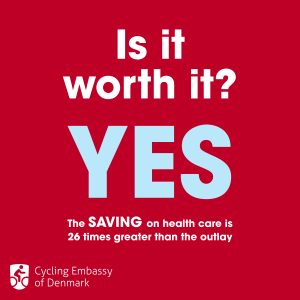
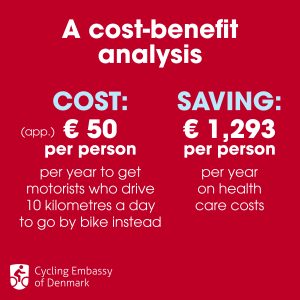
Air pollution is also cited as a risk factor connected with cycling since road users on bicycles with high respiration rates are often close to poisonous exhaust fumes from trucks, busses and cars. Large studies have demonstrated a connection between air pollution in the form of suspended particulates and lung cancer.
When it comes to cycling there are a few studies that can identify a short term effect in relation to asthma- like cases in heavily air polluted areas, but this effect also applies to cars where there are actually higher concentrations of pollution due to the car’s air conditioning system.
No significant long term effects of cycling in polluted areas have been found, but a slightly increased health risk has been identified, which is far outweighed by the health benefits of cycling. One study shows, for example, that cyclists along polluted roads lose between 0.8 -40 days of their life expectancy, but also increase their life expectancy by 314 months due to physical activity.
As in the case of traffic accidents the risk connected with air pollution is in no way commensurate with the health benefits of cycling.
The health utility of cycling
Cycling is healthy, and the physiological and mental benefits gained from cycling far outweigh the risks entailed, such as accidents and pollution. A few hours of cycling a week has a health effect which will be greatest for persons whose lives are physically inactive. There will also be a health reward from cycling several hours a week since it will additionally reduce the risk of illness and premature mortality.
The increase in physical inactivity and overweight that has taken place over recent decades makes it imperative to act. Cycling is a viable option since it can appeal to those who neither can nor will prioritize physical activity either due to lack of time or lack of motivation. Cycling, be it for transport, recreation or training, has a high health utility value for both the individual and society as a whole.
References
Andersen, L.B., Schnohr, P., Schroll, M., & Ole Hein, H. (2000). All-cause mortality associated with physical activity during leisure time, work, sports, and cycling to work. Archives of Internal Medicine, 160(11), 1621-1628.
Beelen, R., Hoek, G., van den Brandt, P. A., Goldbohm, R. A., Fischer, P., Schouten, L. J., . . . Brunekreef, B. (2008). Long-term effects of traffic-related air pollution on mortality in a dutch cohort (NLCS-AIR study). Environmental Health Perspectives, 116(2), 196-202. doi:10.1289/ehp.10767
Bigazzi, A. Y., & Figliozzi, M. A. (2014). Review of urban bicyclists’ intake and uptake of traffic-related air pollution. Transport Reviews, 34(2), 221-245. doi:10.1080/01441647.2014.897772
Blond, K., Jensen, M. K., Rasmussen, M. G., Overvad, K., Tjønneland, A., Østergaard, L., & Grøntved, A. (2016). Prospective study of bicycling and risk of coronary heart disease in danish men and women. Circulation, 134(18), 1409-1411. doi:10.1161/CIRCULATIONAHA.116.024651
Celis-Morales, C. A., Lyall, D. M., Welsh, P., Anderson, J., Steell, L., Guo, Y., . . . Gill, J. M. R. (2017). Association between active commuting and incident cardiovascular disease, cancer, and mortality: Prospective cohort study. BMJ (Clinical Research Ed.), 357, j1456. doi:10.1136/bmj.j1456
De Geus, B., Vandenbulcke, G., Int Panis, L., Thomas, I., Degraeuwe, B., Cumps, E., . . . Meeusen, R. (2012). A prospective cohort study on minor accidents involving commuter cyclists in belgium. Accident Analysis and Prevention, 45, 683-693. doi:10.1016/j.aap.2011.09.045
de Hartog, J. J., Boogaard, H., Nijland, H., & Hoek, G. (2010). Do the health benefits of cycling outweigh the risks? Environmental Health Perspectives, 118(8), 1109-1116. doi:10.1289/ehp.0901747
Götschi, T., Garrard, J., & Giles-Corti, B. (2016). Cycling as a part of daily life: A review of health perspectives. Transport Reviews, 36(1), 45-71. doi:10.1080/01441647.2015.1057877
Götschi, T., Tainio, M., Maizlish, N., Schwanen, T., Goodman, A., & Woodcock, J. (2015). Contrasts in active transport behaviour across four countries: How do they translate into public health benefits? Preventive Medicine, 74, 42-48. doi:10.1016/j.ypmed.2015.02.009
Grøntved, A., Koivula, R. W., Johansson, I., Wennberg, P., Østergaard, L., Hallmans, G., . . . Franks, P. W. (2016). Bicycling to work and primordial prevention of cardiovascular risk: A cohort study among swedish men and women. Journal of the American Heart Association, 5(11) doi:10.1161/JAHA.116.004413
Heesch, K. C., Giles-Corti, B., & Turrell, G. (2014). Cycling for transport and recreation: Associations with socio-economic position, environmental perceptions, and psychological disposition. Preventive Medicine, 63, 29-35. doi:10.1016/j.ypmed.2014.03.003
Holm, A. L., Glümer, C., & Diderichsen, F. (2012). Health impact assessment of increased cycling to place of work or education in copenhagen. BMJ Open, 2(4) doi:10.1136/bmjopen-2012-001135
Kelly, P., Kahlmeier, S., Götschi, T., Orsini, N., Richards, J., Roberts, N., . . . Foster, C. (2014). Systematic review and meta-analysis of reduction in all-cause mortality from walking and cycling and shape of dose response relationship. International Journal of Behavioral Nutrition and Physical Activity, 11(1) doi:10.1186/s12966-014-0132-x
Macmillan, A., Connor, J., Witten, K., Kearns, R., Rees, D., & Woodward, A. (2014). The societal costs and benefits of commuter bicycling: Simulating the effects of specific policies using system dynamics modeling. Environmental Health Perspectives (Online), 122(4), 335. doi:http://dx.doi.org.proxy1-bib.sdu.dk:2048/10.1289/ehp.1307250
Sahlqvist, S., Goodman, A., Simmons, R. K., Khaw, K. -., Cavill, N., Foster, C., . . . Ogilvie, D. (2013). The association of cycling with all-cause, cardiovascular and cancer mortality: Findings from the population-based EPIC-norfolk cohort. BMJ Open, 3(11) doi:10.1136/bmjopen-2013-003797


